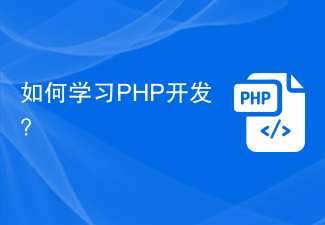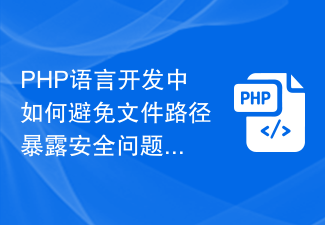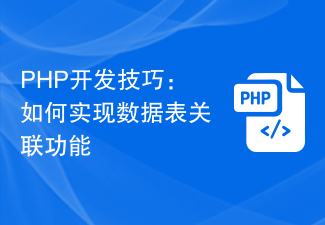 Backend Development
Backend Development PHP Tutorial
PHP Tutorial How to avoid file paths exposing security issues in PHP language development?
How to avoid file paths exposing security issues in PHP language development?With the continuous development of Internet technology, website security issues have become increasingly prominent, among which file path exposure security issues are a common one. File path exposure means that the attacker can learn the directory information of the website program through some means, thereby further obtaining the website's sensitive information and attacking the website. This article will introduce the security issues of file path exposure in PHP language development and their solutions.
1. The principle of file path exposure
In PHP program development, we usually use relative paths or absolute paths to access files, as shown below:
Relative paths: include ("header.php");
Absolute path: include("d:/wwwroot/header.php");
In the above code, if the attacker obtains If you know the true path of the file, you can obtain the sensitive information of the website by accessing the file under the path.
2. Hazards of file path exposure
If an attacker obtains sensitive information of the website through file path exposure, the following harm may occur:
- The site is compromised Hacked, data has been tampered with, or even hacked;
- Personal information leaked, including user privacy information, operating habits, etc.;
- Database utilization, modification and deletion of data, and acquisition of relevant sensitive information;
- The server was attacked, including DDOS, SQL injection, etc.
3. Methods to avoid file path exposure
- Disable error message
PHP’s error message is very detailed. If it is displayed , may contain sensitive file path information. Therefore, in order to avoid the exposure of file path information, we can disable the error message or output it to a log file instead of directly outputting it to the front-end interface, as shown below:
error_reporting(0);
- Define constants
In the program, we can use constants to replace the absolute path, so that even if the attacker obtains the directory information where the program is running through some means, he cannot pass the The information obtains the real path of the file, as follows:
define('APPPath',dirname(__FILE__));
- Check the file path
Use functions such as is_file() in the code to check the legality of the file path. If an attacker attacks by changing the parameters in the URL, if the file name does not exist, an error will be returned immediately without any response. If it exists, the execution of the operation can be generalized, and the attacker will have an interface to perform the operation, which is undesirable by the developer because it would be extremely dangerous. Therefore we need to check the validity of the file path as follows:
if(is_file($fileName)){
//执行操作
}else{
//返回404页面
}
- Turn off the Apache directory browsing function
When the file path is exposed, an attacker may use the Apache directory browsing function to view the directory structure of the website and obtain sensitive information of the website. Therefore, we need to turn off the directory browsing function in the Apache configuration file:
Options -Indexes
- Use URL rewriting
In order to avoid the disclosure of the URL , one way is to rewrite the URL. URL rewriting refers to modifying the format of the URL to make the URL more friendly and beautiful, and to hide the true path of the website. URL rewriting needs to be configured on the server. For specific methods, please refer to the relevant documentation of the server.
4. Conclusion
File path exposure is a very easy security issue and should be taken seriously in PHP program development. In order to avoid file path exposure, we can take various methods, such as disabling error prompts, defining constants, checking file paths, turning off Apache directory browsing functions, and using URL rewriting. By using these measures appropriately, we can better protect the security of PHP programs.
The above is the detailed content of How to avoid file paths exposing security issues in PHP language development?. For more information, please follow other related articles on the PHP Chinese website!
 如何学习PHP开发?Jun 12, 2023 am 08:09 AM
如何学习PHP开发?Jun 12, 2023 am 08:09 AM随着互联网的发展,动态网页的需求越来越大。而PHP作为一种主流的编程语言,被广泛应用于Web开发中。那么,对于初学者来说,如何学习PHP开发呢?一、了解PHP的基础知识PHP是一种脚本语言,可以直接嵌入HTML代码中,通过Web服务器进行解析运行。因此,在学习PHP之前,可以先了解HTML、CSS、JavaScript等前端技术基础,以便更好地理解PHP的作
 PHP语言开发中如何避免文件路径暴露安全问题?Jun 10, 2023 pm 12:24 PM
PHP语言开发中如何避免文件路径暴露安全问题?Jun 10, 2023 pm 12:24 PM随着互联网技术的不断发展,网站的安全问题也日趋突出,其中文件路径暴露安全问题是较为普遍的一种。文件路径暴露指的是攻击者可以通过一些手段得知网站程序的目录信息,从而进一步获取网站的敏感信息,对网站进行攻击。本文将介绍PHP语言开发中的文件路径暴露安全问题及其解决方法。一、文件路径暴露的原理在PHP程序开发中,我们通常使用相对路径或绝对路径访问文件,如下所示:相
 PHP语言开发中避免跨站脚本攻击安全隐患Jun 10, 2023 am 08:12 AM
PHP语言开发中避免跨站脚本攻击安全隐患Jun 10, 2023 am 08:12 AM随着互联网技术的发展,网络安全问题越来越受到关注。其中,跨站脚本攻击(Cross-sitescripting,简称XSS)是一种常见的网络安全隐患。XSS攻击基于跨站点脚本编写,攻击者将恶意脚本注入网站页面,通过欺骗用户或者通过其他方式植入恶意代码,获取非法利益,造成严重的后果。然而,对于PHP语言开发的网站来说,避免XSS攻击是一项极其重要的安全措施。因
 使用 PHP 开发网络爬虫和数据抓取工具的技巧Sep 11, 2023 pm 03:54 PM
使用 PHP 开发网络爬虫和数据抓取工具的技巧Sep 11, 2023 pm 03:54 PM使用PHP开发网络爬虫和数据抓取工具的技巧网络爬虫是在互联网上自动获取信息的程序,是很多数据分析和挖掘任务的必备工具。PHP是一种广泛使用的脚本语言,具有易学易用、灵活性高的特点,非常适合用来开发网络爬虫和数据抓取工具。本文将介绍一些使用PHP开发网络爬虫和数据抓取工具的技巧。一、了解目标网站的结构和数据来源在开发网络爬虫之前,我们首先要对目标网站进行分
 PHP开发技巧:如何实现数据表关联功能Sep 21, 2023 pm 01:43 PM
PHP开发技巧:如何实现数据表关联功能Sep 21, 2023 pm 01:43 PMPHP开发技巧:如何实现数据表关联功能在进行Web开发中,数据表关联是一个非常重要的技术。通过关联不同数据表之间的数据,可以实现更加复杂和灵活的数据查询和操作功能。本文将为您介绍如何使用PHP实现数据表关联功能,并提供具体的代码示例。一、准备工作在开始之前,我们需要先创建两个相关联的数据表。以学生和课程两个实体为例,我们分别创建一个学生表和一个课程表。学生表
 PHP开发的10个调试技巧May 24, 2023 am 08:23 AM
PHP开发的10个调试技巧May 24, 2023 am 08:23 AM在PHP开发过程中,调试是不可避免的一个过程。但是有些开发者在遇到问题时,往往会采用非常低效的方法进行调试,比如打断点、输出调试信息等。这些方法并不一定能够有效地解决问题,同时还会损失很多时间和精力。为此,本文将介绍PHP开发中10个高效的调试技巧,相信这些技巧能够帮助PHP开发者更快更准确地解决问题。使用xdebugxdebug是PHP调试过程中的一款强大
 Java开发技巧大揭秘:优化代码性能的实用方法Nov 20, 2023 am 08:10 AM
Java开发技巧大揭秘:优化代码性能的实用方法Nov 20, 2023 am 08:10 AMJava开发技巧大揭秘:优化代码性能的实用方法概述在日常Java开发中,我们经常会遇到性能问题,比如代码运行缓慢、内存占用过高等。优化代码性能可以提高程序的响应速度,减少资源占用,提升用户体验。本文将介绍一些实用的方法和技巧,帮助开发人员优化Java代码的性能。一、使用合适的数据结构数据结构的选择对代码性能有着重要影响。在使用集合类时,应根据具体的需求选择合
 Java开发技巧大揭秘:优化字符串拼接的方法Nov 20, 2023 am 09:53 AM
Java开发技巧大揭秘:优化字符串拼接的方法Nov 20, 2023 am 09:53 AMJava作为一种广泛应用于软件开发的编程语言,其灵活性和可扩展性使得它成为许多开发者的首选。在Java开发中,字符串拼接是一项常见且重要的任务。然而,不正确的字符串拼接方法可能导致性能下降和资源浪费。为了解决这个问题,本文将揭秘一些优化字符串拼接的方法,帮助开发人员在日常工作中更高效地处理字符串。首先,让我们来了解一下Java中字符串的不可变性。在Java中


Hot AI Tools

Undresser.AI Undress
AI-powered app for creating realistic nude photos

AI Clothes Remover
Online AI tool for removing clothes from photos.

Undress AI Tool
Undress images for free

Clothoff.io
AI clothes remover

AI Hentai Generator
Generate AI Hentai for free.

Hot Article

Hot Tools

Atom editor mac version download
The most popular open source editor

Dreamweaver CS6
Visual web development tools

Safe Exam Browser
Safe Exam Browser is a secure browser environment for taking online exams securely. This software turns any computer into a secure workstation. It controls access to any utility and prevents students from using unauthorized resources.

MantisBT
Mantis is an easy-to-deploy web-based defect tracking tool designed to aid in product defect tracking. It requires PHP, MySQL and a web server. Check out our demo and hosting services.

Zend Studio 13.0.1
Powerful PHP integrated development environment





